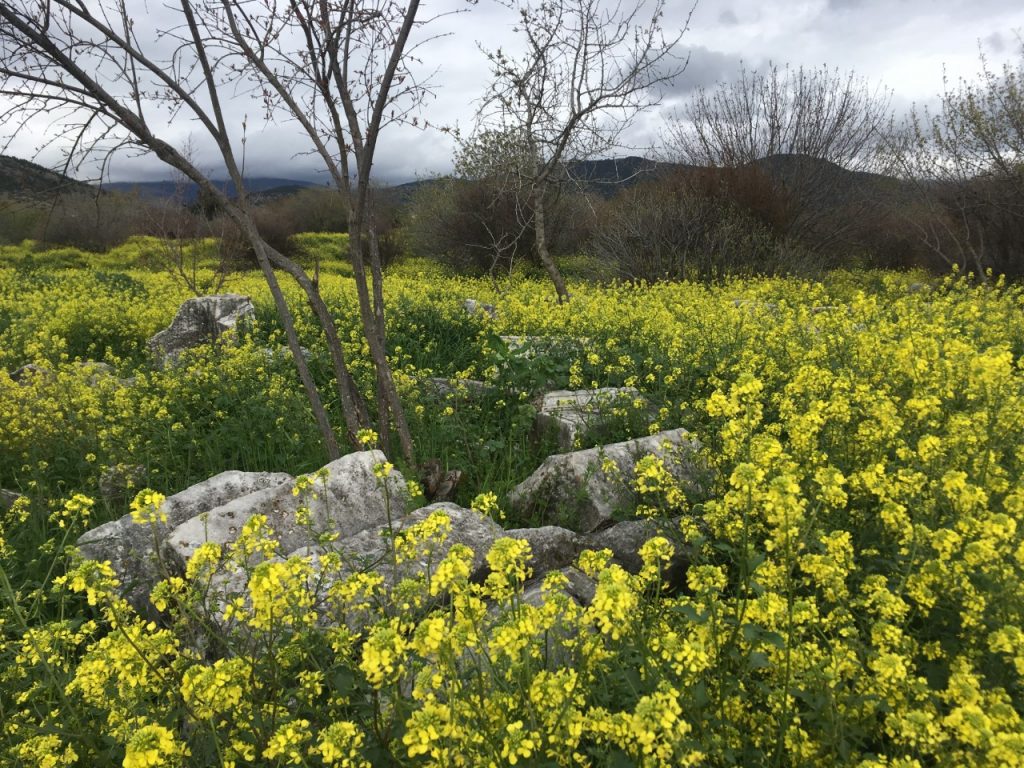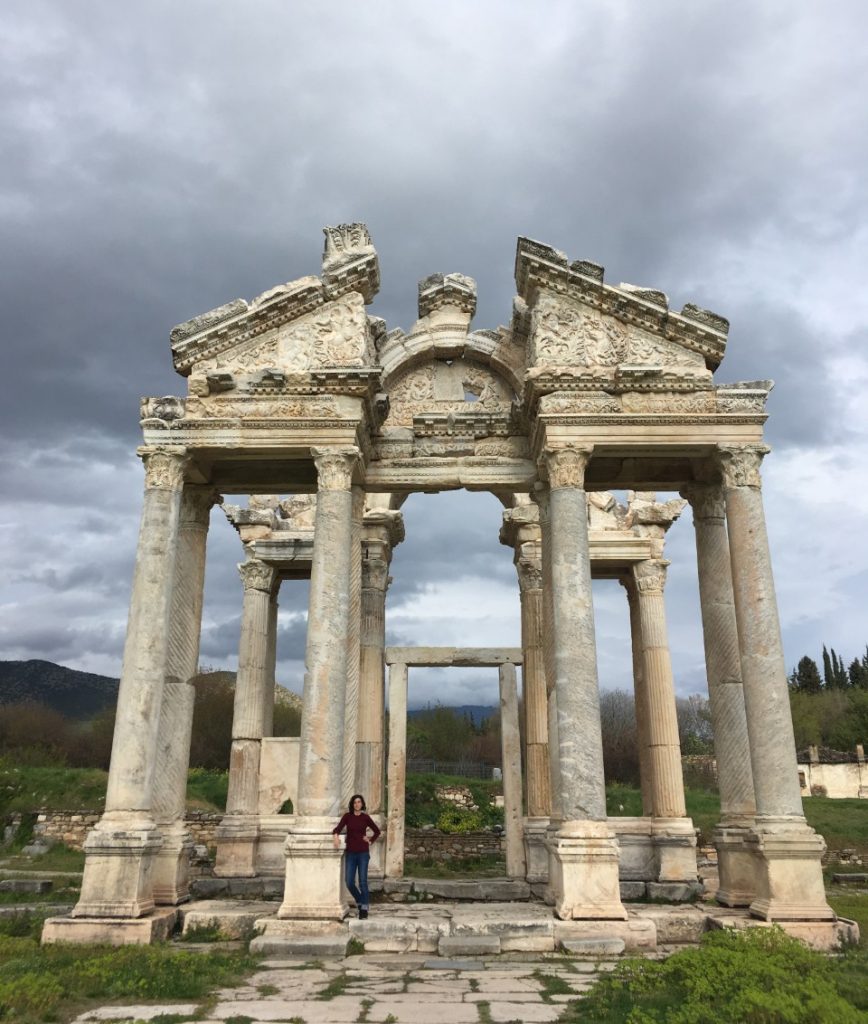In a vast, seemingly endless field near the village of Geyre, west of Denizli, the white marble structures of Aphrodisias seemed to glow hauntingly under the dark skies. This sacred site is stunning. Devoted to Aphrodite, the Greek Goddess of love and beauty, this ancient Hellenistic city has come to be known as “the city of love”. Seçkin, my husband and I came here on a whim. Work had brought us to Denizli and we had finished early so we had the rest of the day free. The forecast looked like rain, but we were determined not to let that stop us from going. It was April, so the weather could be unpredictable but we lucked out. Unlike some archaeological sites around Turkey, this site was guarded and protected. We paid an entry fee but didn’t have to worry about security lurking behind us. Upon entrance, we saw an extensive collection of sarcophagi displayed across the lawn. Many of them were decorated with carved reliefs of garland, faces and even figures. I loved seeing how nature had taken over and filled their empty insides with life. Further down the path, we encountered an impressive wall filled with marble faces carved onto blocks, many of them with dramatic expressions. We came to learn that each block was once part of a frieze that framed the south agora (in ancient Greece, this was a public space used for assemblies and markets). What an astonishing sight this must have been to see while out on a grocery run.

Aphrodisias is one of the best-preserved ancient cities of Anatolia. Full of magnificent structures that are ornately decorated and meticulously carved by a masterful hand, there is a whole world to explore. The first impressive building we saw was the Sebasteion (Greek for Temple of Augustus) a temple complex dedicated to Aphrodite and the Roman emperors. The facades of the structure were breathtaking to see in person. Full figure sculptured reliefs carved into the panels that adorn this majestic monument. I could spend hours just looking at the intricate details in the architecture. This building was a masterpiece to say the least.
Scattered throughout the site are countless broken and eroded relics everywhere. They seemed to sink into the shadows or disappear into the tall grass. I thought of these areas as gardens of ancient leftovers. What were these pieces a larger part of? Were they just as important as the standing structures? Are they safe out in the open like this? Marble columns are abundant throughout the site. Many are weathered and have broken or cracked over time but some still manage to firmly stand their ground. Drifting along the path, we were amazed by the abundance of nature that bloomed all around us. Triumphant were the poppies and yellow wildflowers that ran rampant across the terrain and illuminated Aphrodisias with a vigorous energy. I wanted to frolic in this dense jungle pretending I was Aphrodite herself bathing in the land of milk and honey.

I was quite taken with the Baths of Hadrian. Named in honor of the emperor Hadrian, this bath complex functioned as an important part of the culture at Aphrodisias and provided a place of rest and relaxation. Parts of the classic black and white checkered tile floor still remain and have most likely been restored. The walls were once covered in marble as well but now only the limestone foundations remain to be seen. An enormous marble sculpture of a male torso towered over us as we moved through the space. I asked Seçkin if this was real. It was hard to believe since I’m not used to being around gigantic marble sculptures in my daily life. I imagined this was once a glorious bath house full of locals catching up on the latest gossip while they soaked in a hot bath. Suppose you were taking a bath with your neighbors when a tiger wanders in and strolls over to take a sip of water from the pool. So, what’s more bizarre, bathing with your neighbors or encountering a tiger? This is what happens when I let my imagination run wild.
We further explored the premises and came to find there is also a bouleutrion (council house) with a semi-circle auditorium, a massive stadium that held up to 30,000 spectators used by athletes, gladiators and for wild animal games. The most important structure of Aphrodisias and its main focus was The Temple of Aphrodite, where the cult statues once lived. I weaved by body back and forth around the columns and wondered what it must have been like to feel the energy of others as they came here to lay offerings for Aphrodite. How did they feel about her? Did they fear her or were their hearts full of love for her?

We also climbed the marble stairs to the top of an expansive theatre complex that once accommodated up to 8,000 spectators. I loved that it was open-air and left the audience exposed to the sky. Imagine what it must have felt like to be here just before a thunderstorm. Exposed to the mercy of the Gods and Goddesses with nowhere to hide. Looking around, I noticed many symbols carved into the stone near the entry ways and on random tiles underfoot. Many of these symbols were circles with a simple floral design or the wheel of fortune motif.
Aphrodisias became known throughout the ancient Roman world for its remarkable sculptures and it was famous for its sculpture school. Many aspiring sculptors traveled from faraway places to learn the craft from the masters who taught here. Since there once was a marble quarry not far from here, artisans had a constant supply of the raw material at hand. There was an entire area dedicated to the school complete with workshops and an outdoor studio where the students carved the marble. There was also a designated area for storing and repairing the sculptures. Excavations later revealed finished and unfinished sculptures and showed that many students carved mythological creatures and contemporary portraits. It must have been an exciting time to be an aspiring sculptor and learn the trade here in the heart of the marble tradition.

The Tetrapylon was the last hurrah and is not to be missed. This magnificent structure once served as a portal that connected the main street with the Temple of Aphrodite. Prepared to be captivated by this iconic megalith as you pass through and walk around it. I traced my fingers over the spirals that wrap around the colonnade and glided my hand over the blue veins of smooth marble still warm from the sun. When you visit here, I encourage you to take a moment to look up and watch the sky as clouds sweep by overhead. Clouds or spirits? I’ll let you decide.
It felt like I had passed through a dream…
When we reached the end of our journey, we were reminded that there was still the museum to visit. Unfortunately, it had closed for the day. We had lost track of time, mesmerized by the wonders and impeccable beauty of Aphrodisias.
Images courtesy of the author.








